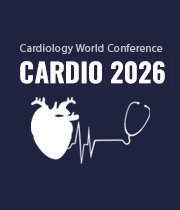Title : Assessment of right ventricular systolic function by two dimensional echocardiography and longitudinal strain: Is right ventricular systolic function influenced by right atrial function?
Abstract:
Right ventricular (RV) systolic function is impaired in several cardiopulmonary diseases, including heart failure of varied etiologies, valvular diseases, cardiomyopathies, pulmonary hypertension, acute pulmonary embolism, collagen vascular diseases and pericardial diseases. Examination of RV function is inherently difficult, but a combination of conventional two-dimensional echocardiography (2D echo) and global longitudinal strain (LS) using speckle tracking has proven useful in assessing RV systolic function. Commonly used 2D echo indices recommended by the American Society of Echocardiography (ASE) for assessing RV systolic function include RV fractional area change (FAC), tricuspid annular plane systolic excursion (TAPSE), peak systolic velocity of tricuspid annulus (S’) and right ventricular index of myocardial performance (RIMP). Using these indices, RV systolic function has been shown to be impaired in patients with heart failure with preserved as well as with reduced LV ejection fraction, dilated cardiomyopathies, myocardial infarction, mitral valve disease, and aortic stenosis, both before and after aortic valve replacement. RV systolic function is also impaired in constrictive pericarditis due to myocardial infiltration of the RV by pericardial diseases. Although the above 2D echo parameters provide an estimate of RV systolic function, strain is a superior measure of velocity of shortening or cardiac contractility (i.e., the “strength” of contraction). RV LS is defined as normal if the percentage of systolic shortening of the RV is ≥20%, that is, <20% abnormal. LS can also be used to provide information on right atrial (RA) function beyond the data on RA size and function that can be obtained using 2D echo. The RA plays three major roles that influence RV filling and systolic function: it acts as (1) a contractile pump, (2) a reservoir for caval venous return, and (3) a conduit for the passage of blood from the RA to RV. In recent studies using a combination of 2D echo and LS, all three components of RA function and RV systolic function were found to be reduced in constrictive pericarditis. These findings indicate that LS has promise as a measure for quantifying RA function in other diseases affecting the RV, allowing improved tracking of the clinical course and treatment outcome.



